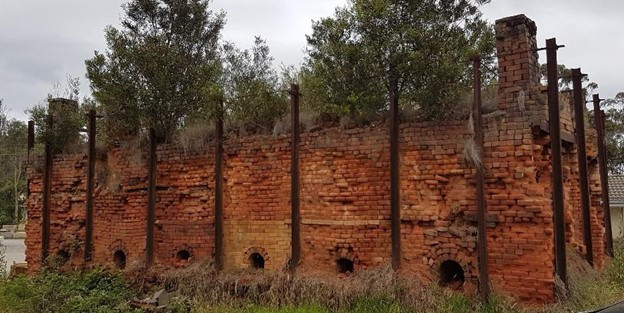South Coast NSW History Story
Kalaru Brick Kilns
The Kalaru Brick Kilns
Five old brick kilns are a distinctive feature beside the Tathra Road at the western end of Kalaru (between Tathra and Bega).
The first of these was built in 1939 and they were used for clay brickmaking until 1990. Huge quantities of bricks were manufactured in them. These were used in Bega, Tathra and other south coast towns, as well as in buildings and power stations that were constructed by the Snowy Mountains Hydro-Electric Authority.
But the story of these brickworks really starts over 50 years earlier.
In 1883 a 24-year-old bricklayer’s assistant and moulder of handmade bricks, William Stafford, arrived in Sydney from England. He first found work in Sydney as a bricklayer, but soon moved to the country to lay bricks on culverts and railway tunnels on the railway lines that were being constructed between Sydney and Goulburn and in the Bathurst-Blayney-Cowra area.
At that time he met, and soon married, a widow by the name of Harriet McGovern. Her husband had been killed when the brakes on his wagon failed and he was run over by his wagon and a team of eight horses on Goulburn Hill. Harriet had four children – Patrick and Jimmy (who coincidentally were employed by another brickmaker in Carcoar as ‘pug boys’ (working in the pug mill where the clay, water and other additives were mixed)) and two girls.
Combining young Patricks’ knowledge with his own experience, William Stafford began making bricks for the Goulburn-line railway tunnels. When the line was completed, William and Patrick moved to Cooma where they established a brickworks.
When the Pambula goldfields opened in the early 1890s, William started making bricks on the Lochiel Road – his first contract being to supply bricks for the Pambula Police Station and Courthouse (now the home of the Bega Valley Genealogical Society).
William and Harriet had five sons (and a daughter). All these sons became brickmakers, as did Jimmy McGovern. So the Stafford-McGovern families manufactured bricks at many sites around the south coast and the Monaro (with hand-made bricks often being produced on-site because this was usually cheaper than transporting bricks from a central brickworks), and continued to do so until the early 1950s.
In the early 1920s, Lot Stafford (the third of William and Harriet’s sons) established a brickworks in Bega in the area of Kisses Lagoon, at the western end of the town, and in 1927 moved further east along the Tathra Road to what proved to be a flood-prone site.
Around 1933 Lot purchased 40 acres in Kalaru (the site of the surviving brickworks) and set up business there. He initially built two up-draught kilns and a drying shed for the manufacturing of hand-made bricks.
By the mid-1930s demand for bricks from Stafford’s new brickworks exceeded production capacity, so production of hand-made bricks was phased out in 1936-1937 and was replaced by mechanised dry-press brick manufacturing, utilising machinery purchased from brickworks that had once operated in Moss Vale and Captains Flat.
It was discovered, however, that the existing up-draft brick kilns did not deliver temperatures that were high enough to satisfactorily fire dry-press bricks, so in 1939 the first of five down-draught kilns were erected (the middle one in the row nearest to the Tathra Road, which was capable of firing 50,000 bricks in a single batch).
World War II building restrictions, however, effectively closed down the new Kalaru brickworks – an exception being given for it to produce enough bricks to build nurses quarters in Bega.
After the war demand for bricks soared (for example, 1.2 million bricks were supplied for the construction of Bega Hospital; the Staffords also produced some specially-shaped hexagon shaped bricks for the hospital’s chimney stack) so four additional down-draught kilns were erected at Kalaru and a second dry-press production line was installed. At this time about 16 men were employed making bricks and considerable work was provided by the brickworks to trucking companies and wood suppliers. (As an aside, the earliest trucks could only carry around 3 tons or 1,000 bricks per delivery and an average house would require about 25,000 bricks.)
The Stafford’s brickworks at Kalaru was the closest brickworks to the Snowy Mountains, so bricks were supplied to the Snowy Mountains Scheme as fast as they could be produced – with bricks being hand loaded onto and off table-top trucks, and the trucks having to traverse unsealed potholed roads for many years.
These historic brick kilns at Kalaru are believed to be the last in the country to fire bricks that were hand moulded in entirely wood-fuelled kilns.
Sources: ‘Foundations of the Past. The history of the Stafford Family and Brickmaking’ by Ron Stafford, 2006, and ‘100 years of Stafford Family History’, 1996
